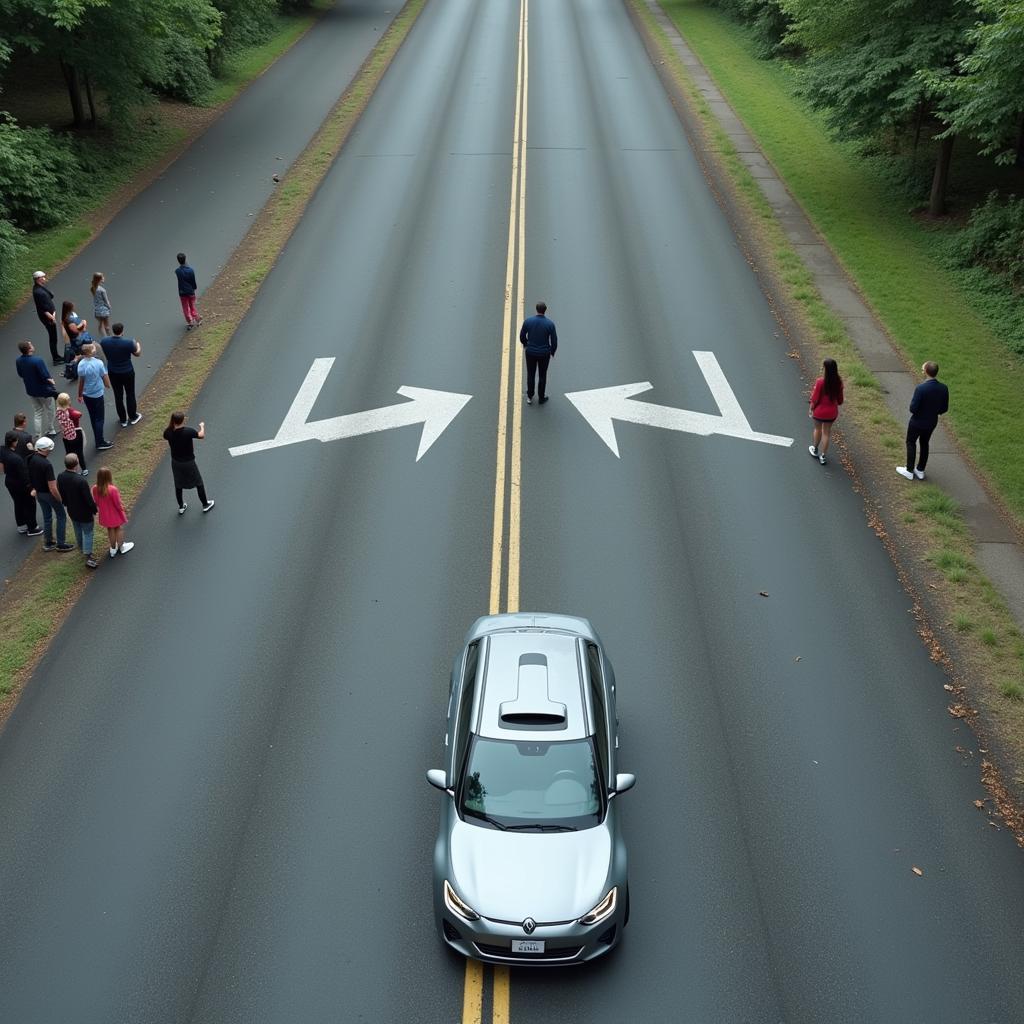The Self-driving Car Trolley Problem is a thought experiment that explores the ethical dilemmas posed by artificial intelligence (AI) in self-driving vehicles. This complex issue involves the potential for AI-driven cars to make life-or-death decisions in the event of an unavoidable accident, forcing us to grapple with difficult moral questions about how these decisions should be made.
The Trolley Problem and Its Relevance to Self-Driving Cars
The classic trolley problem presents a scenario where a runaway trolley is headed towards a group of five people. You have the option to switch the trolley onto a different track where only one person is standing. The dilemma lies in choosing between letting five people die or sacrificing one person. This problem has been widely discussed in philosophy and ethics, but it takes on a new dimension in the context of self-driving cars.
As self-driving cars become more prevalent, they will inevitably encounter situations where a collision is unavoidable. In these cases, the car’s AI will need to make a decision about who to harm, potentially resulting in the death of one or more individuals. This raises critical questions about:
- Whose life should be prioritized? Should the car prioritize the safety of its passengers, pedestrians, or other road users?
- How should the car weigh different factors? Should age, health, or other personal characteristics play a role in its decision-making process?
- Who is responsible for the car’s actions? Is the manufacturer, the driver, or the AI itself accountable for any deaths that occur?
 Self-driving car facing ethical dilemma
Self-driving car facing ethical dilemma
Ethical Considerations in Programming Self-Driving Cars
The self-driving car trolley problem highlights the urgent need for ethical considerations in programming autonomous vehicles. Developers and policymakers face a daunting challenge in determining the best approach to address these dilemmas.
Here are some key ethical frameworks that are being considered:
- Utilitarianism: This framework suggests that the car should prioritize the action that results in the greatest overall good, potentially sacrificing one life to save multiple others.
- Deontology: This approach focuses on moral duty and the inherent rights of individuals, arguing that the car should avoid harming anyone at all costs, even if it means risking more lives.
- Virtue ethics: This framework emphasizes the importance of character and moral development, suggesting that the car’s decision-making should reflect principles of compassion, fairness, and responsibility.
The Challenge of Programming Moral Values into AI
A major challenge in addressing the trolley problem lies in the difficulty of programming moral values into AI. While humans can instinctively make moral judgments based on experience and intuition, AI systems rely on algorithms and data sets that are programmed by humans.
Dr. Alice Thompson, a leading AI ethics researcher, comments: “The key issue is that we are trying to imbue AI with human-like moral reasoning, but AI lacks the same capacity for understanding complex social contexts and values.”
This inherent limitation raises concerns about the potential for bias and unintended consequences in AI decision-making. It also highlights the importance of involving diverse perspectives and ethical expertise in the development and deployment of self-driving cars.
Moving Forward: Finding Solutions to the Self-Driving Car Trolley Problem
The self-driving car trolley problem presents a complex challenge for society. Finding solutions will require collaboration between engineers, ethicists, policymakers, and the public.
Here are some steps we can take:
- Develop clear ethical guidelines for AI decision-making. These guidelines should address questions of responsibility, transparency, and accountability.
- Promote public discourse on the ethical implications of self-driving cars. Engaging the public in these conversations is essential for building societal consensus and trust.
- Conduct ongoing research and development of AI technologies. We need to ensure that AI systems are designed to be safe, reliable, and aligned with human values.
Conclusion
The self-driving car trolley problem is a stark reminder of the ethical complexities of artificial intelligence. As we navigate this new frontier, it’s critical to engage in thoughtful discussions about the values and principles that should guide AI decision-making. Finding solutions that balance innovation with ethical considerations will be essential for creating a safe and just future for all.
For expert guidance and solutions to your automotive challenges, contact AutoTipPro:
Phone: +1 (641) 206-8880
Office: 500 N St Mary’s St, San Antonio, TX 78205, United States
FAQ
1. What is the trolley problem?
The trolley problem is a thought experiment in ethics that presents a scenario where you must choose between two actions, each with negative consequences.
2. Why is the trolley problem relevant to self-driving cars?
Self-driving cars are programmed to make decisions in complex situations, including those where a collision is unavoidable. The trolley problem highlights the need for ethical considerations in these decision-making processes.
3. How can we ensure that self-driving cars make ethical decisions?
Developing ethical guidelines, promoting public discourse, and conducting ongoing research and development are essential steps toward ensuring that AI systems are safe, reliable, and aligned with human values.
4. Who is responsible for the actions of a self-driving car?
This is a complex question that involves multiple stakeholders, including the manufacturer, the driver, and the AI itself. Clear legal and ethical frameworks are needed to address this issue.
5. What are the potential risks of AI-driven cars?
Risks include the potential for bias, unintended consequences, and the need for robust safety measures.
6. How can we address the ethical challenges posed by AI?
Through open dialogue, collaboration, and continuous research, we can strive to create AI systems that are aligned with human values and promote a safe and just future.




Leave a Reply